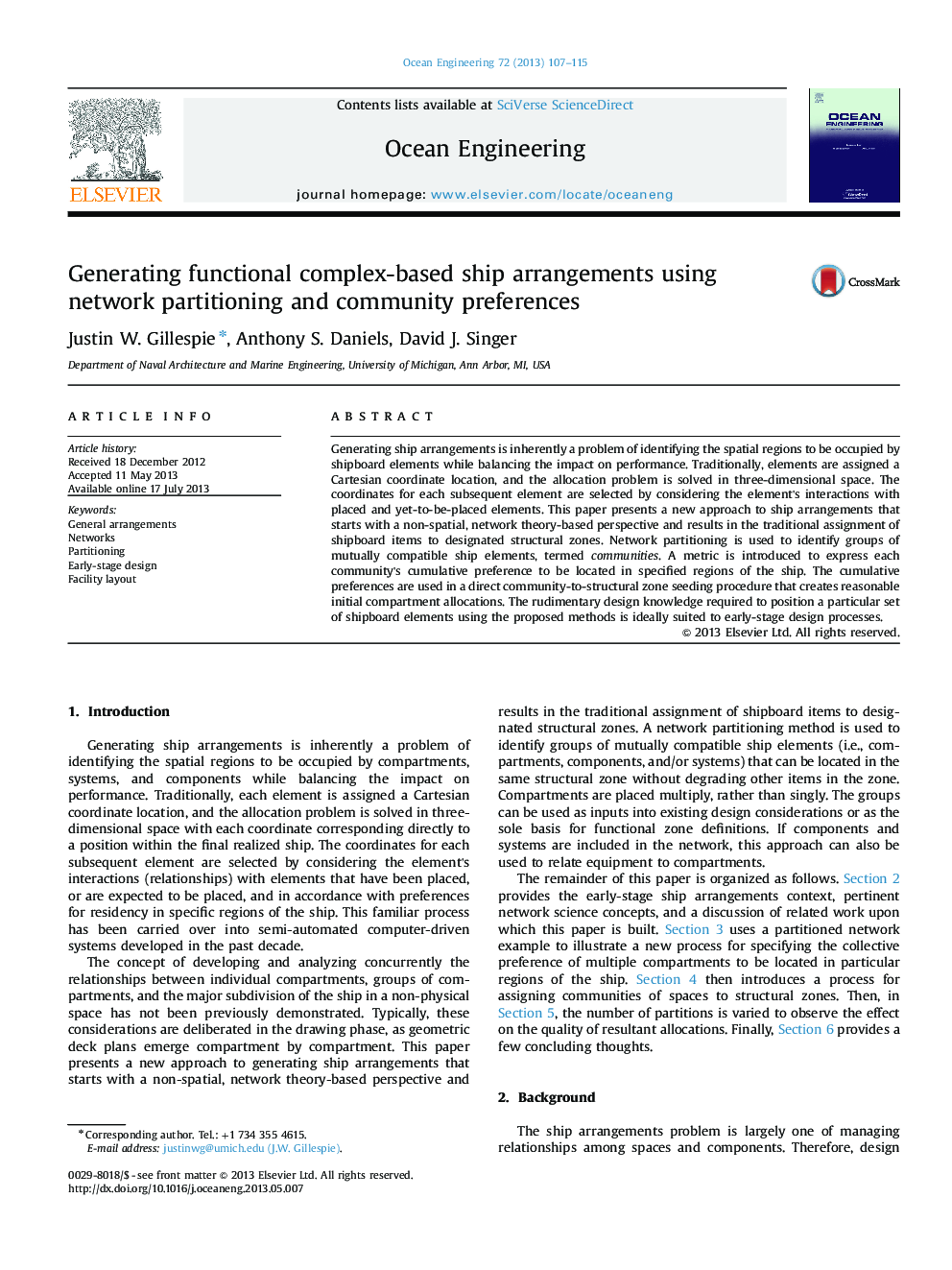| کد مقاله | کد نشریه | سال انتشار | مقاله انگلیسی | نسخه تمام متن |
|---|---|---|---|---|
| 8066483 | 1520718 | 2013 | 9 صفحه PDF | دانلود رایگان |
عنوان انگلیسی مقاله ISI
Generating functional complex-based ship arrangements using network partitioning and community preferences
ترجمه فارسی عنوان
ایجاد تسهیلات کشتی مبتنی بر مجموعه عملیاتی با استفاده از پارتیشن بندی شبکه و تنظیمات محلی
دانلود مقاله + سفارش ترجمه
دانلود مقاله ISI انگلیسی
رایگان برای ایرانیان
کلمات کلیدی
ترتیبات عمومی، شبکه های، تقسیم بندی، طراحی اولیه طرح تسهیلات،
ترجمه چکیده
ترتیب تولید کشتی ها به طور ذاتی مشکل شناسایی مناطق مکانی که توسط عناصر کشتی اشغال می شوند در حالی که متعادل کردن تاثیر بر عملکرد است. به طور سنتی، عناصر یک محل مختصات دکارتی تعیین می شوند، و مسئله تخصیص در فضای سه بعدی حل می شود. مختصات برای هر عنصر بعدی با در نظر گرفتن تعامل عنصر با عناصر قرار داده شده و هنوز به قرار داده شده انتخاب شده است. این مقاله رویکرد جدیدی را به ترتیب کشتی ارائه می دهد که از منظر مبتنی بر نظریه شبکه به صورت غیر فضایی آغاز می شود و در نتیجه انتساب سنتی اقلام کشتی به مناطق ساختاری مشخص شده است. پارتیشن بندی شبکه برای شناسایی گروه های عناصر کشتی متقابل سازگار، نامیده می شود جوامع استفاده می شود. یک متریک معرفی شده است تا اولویت تجمعی هر یک از جوامع را در قسمت های مشخصی از کشتی نشان دهد. ترجیحات تجمعی در روش کاشت بومی مستقیم به ساختار به کار می رود که ایجاد توزیع مجدد محدوده منطقی را ایجاد می کند. دانش طراحی ابتدایی مورد نیاز برای قرار دادن یک مجموعه خاص از عناصر کشتی با استفاده از روش های پیشنهادی، ایده آل برای فرایندهای طراحی اولیه است.
موضوعات مرتبط
مهندسی و علوم پایه
سایر رشته های مهندسی
مهندسی دریا (اقیانوس)
چکیده انگلیسی
Generating ship arrangements is inherently a problem of identifying the spatial regions to be occupied by shipboard elements while balancing the impact on performance. Traditionally, elements are assigned a Cartesian coordinate location, and the allocation problem is solved in three-dimensional space. The coordinates for each subsequent element are selected by considering the element's interactions with placed and yet-to-be-placed elements. This paper presents a new approach to ship arrangements that starts with a non-spatial, network theory-based perspective and results in the traditional assignment of shipboard items to designated structural zones. Network partitioning is used to identify groups of mutually compatible ship elements, termed communities. A metric is introduced to express each community's cumulative preference to be located in specified regions of the ship. The cumulative preferences are used in a direct community-to-structural zone seeding procedure that creates reasonable initial compartment allocations. The rudimentary design knowledge required to position a particular set of shipboard elements using the proposed methods is ideally suited to early-stage design processes.
ناشر
Database: Elsevier - ScienceDirect (ساینس دایرکت)
Journal: Ocean Engineering - Volume 72, 1 November 2013, Pages 107-115
Journal: Ocean Engineering - Volume 72, 1 November 2013, Pages 107-115
نویسندگان
Justin W. Gillespie, Anthony S. Daniels, David J. Singer,
